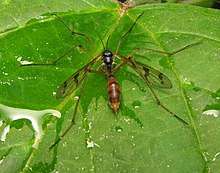Ptychopteridae
The Ptychopteridae, phantom crane flies, are a small family (three extant genera) of nematocerous Diptera. Superficially similar in appearance to other "tipuloid" families, they lack the ocelli of the Trichoceridae, the five-branched radial vein of the Tanyderidae, and the two anal veins that reach the wing margins of the Tipulidae. They are usually allied with the Tanyderidae based on similarities of the mesonotal suture, this group being called the Ptychopteromorpha.
| Ptychopteridae | |
|---|---|
 | |
| Ptychoptera contaminata | |
| Scientific classification | |
| Kingdom: | Animalia |
| Phylum: | Arthropoda |
| Class: | Insecta |
| Order: | Diptera |
| Suborder: | Nematocera |
| Infraorder: | Ptychopteromorpha |
| Family: | Ptychopteridae Osten-Sacken, 1862 |
| Genera | |
| |
Life history
Egg
Ptychoptera albimana (Palearctic) has a mean of 554 eggs laid. The shape is slightly arcuated, "curiously ornamented", and roughly 0.8 mm × 0.2 mm (0.0315 in × 0.0079 in). Duration is reported at 7 days.
Larvae
The larvae are eucephalous and distinctive for the long, caudal respiratory siphon they possess. At hatching, they measure just under 4 mm (0.16 in) in P. albimana, quickly growing to nearly 80 mm (3.1 in). They occur in moist habitats (described as "wet swales and meadows" for Ptychoptera; along lentic shorelines and alder swamps for Bittacomorpha) where they feed as collector-gatherers on decaying organic matter.
Pupae
The pupae possess a single, greatly elongated spiracular horn protruding from their thoraces. In Ptychoptera and Bittacomorpha, the right horn is elongated; in Bittacomorphella, the left. Reported times spent in this stage vary from 5 to 12 days.

Adult
The adults are found most often from late spring through to autumn in shaded, moist environs. Presumably, adults feed little, if at all. Two generations occur per year.
The common species of Eastern North America (Bittacomorpha clavipes) is known for the odd habit of spreading out its legs while flying, using expanded, trachea-rich tarsi to waft along on air currents.
Why they are called “phantom” crane flies: Their legs are thin and black with white sheaths near the tips, and when they fly under a shady tree, everything disappears except the white spots, appearing and disappearing like a “phantom”.
Subfamilies
Ptychopterinae – 16 antennomeres; M1 cell present
- Ptychoptera Meigen, 1803
Bittacomorphinae – 20 antennomeres; M1 & M2 veins fused, thus without M1 cell
- Bittacomorpha Westwood, 1835
- Bittacomorphella Alexander, 1916
The general appearance of the two forms is strikingly different. The species of the Bittacomorphinae are similar in size and shape to the Tipulidae, but exhibit a striking black and white coloration — hence the common name "phantom crane flies". The two genera differ as adults in their size and the extent of white coloration on the legs. The larvae of Bittacomorphella possess unique protuberances not seen in the other two genera. Ptychoptera species resemble large mycetophilids, being generally a shiny black and often with patterned wings.
Species
| Scientific name | Authority[1] | Location | Comments |
|---|---|---|---|
| Bittacomorpha (Westwood, 1835) | |||
| Bittacomorpha clavipes aka Tipula clauipes | Fabricius, 1781 (both variants) | Eastern North America, ranging as far west as the Rocky Mountains | The most common and distinctive species |
| Bittacomorpha occidentalis | Aldrich, 1895 | Pacific Northwest | |
| Bittacomorphella (Alexander, 1916) | |||
| Bittacomorphella esakii | Tokunaga, 1938 | Japan | |
| Bittacomorphella fenderiana | Alexander, 1947 | Queen Charlotte Islands, south to Oregon | Often confused with one another in the literature until the mid-1900s, when Alexander delimited them based on the male hypopygium. |
| Bittacomorphella jonesi | Johnson, 1905 | New England, south to North Carolina also seen in Minnesota and Michigan | |
| Bittacomorphella nipponensis | Alexander, 1924 | ||
| Bittacomorphella pacifica | Alexander, 1958 | Northern California, north to Oregon | |
| Bittacomorphella sackenii | Röder, 1890 | Sierra Nevadas | |
| Bittacomorphella thaiensis | Alexander 1953 | ||
| Ptychoptera (Meigen, 1803) | |||
| Ptychoptera byersi | Alexander, 1966 | California | |
| Ptychoptera lenis | Osten-Sacken, 1877 | P. l. lenis: Pacific Northwest P. l. coloradensis: Colorado and Utah | 2 subspecies, as enumerated to the left |
| Ptychoptera metallica | Walker, 1848 | Central Canada, Minnesota, Michigan | |
| Ptychoptera minor | Alexander, 1920 | California, Idaho | |
| Ptychoptera monoensis | Alexander, 1947 | Northern California | similar to P. pendula and P. townesi |
| Ptychoptera osceola | Alexander, 1959 | Florida | similar to P. quadrifasciata |
| Ptychoptera pendula | Alexander, 1937 | British Columbia, south to Utah and Colorado | similar to P. minor |
| Ptychoptera quadrifasciata aka P. rufocinctus | Say, 1824 | Eastern United States | |
| Ptychoptera sculleni | Alexander, 1943 | Pacific Northwest | considered to be fairly distinct based on male genitalia |
| Ptychoptera townesi | Alexander, 1943 | Washington, Oregon | similar to P. pendula |
| Ptychoptera uta | Alexander, 1947 | Utah | similar to P. l. coloradensis |
References
- Alexander, C.P. 1928. Diptera. Fam. Ptychopteridae. Genera Insectorum 188: 1–12
Further reading
- Borror, D.J., C.A. Triplehorn, & N.A. Johnson. 1989. An Introduction to the Study of Insects, Sixth edition. Saunders College Publishing.
- Byers, G.W. & D.A. Rossman. 2004. Preliminary survey of the crane flies of Louisiana (Diptera: Tipulidae, Ptychopteridae). Proceedings of the Entomological Society of Washington, 106: 884–890.
- Stubbs, A.E. 1993. Provisional Atlas of the Ptychopteroid Craneflies (Diptera: Ptychopteridae) of Britain and Ireland. Centre for Ecology and Hydrology.
- Zwick, P. 2004. Fauna Europaea: Ptychopteridae. In: Fauna Europaea: Diptera: Nematocera. H. DeJong, ed.